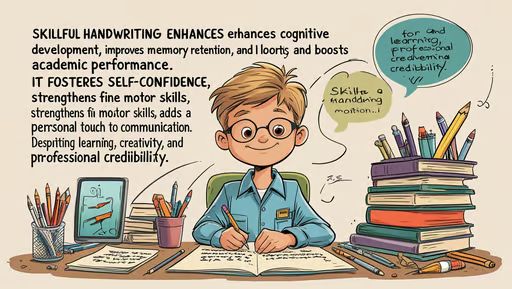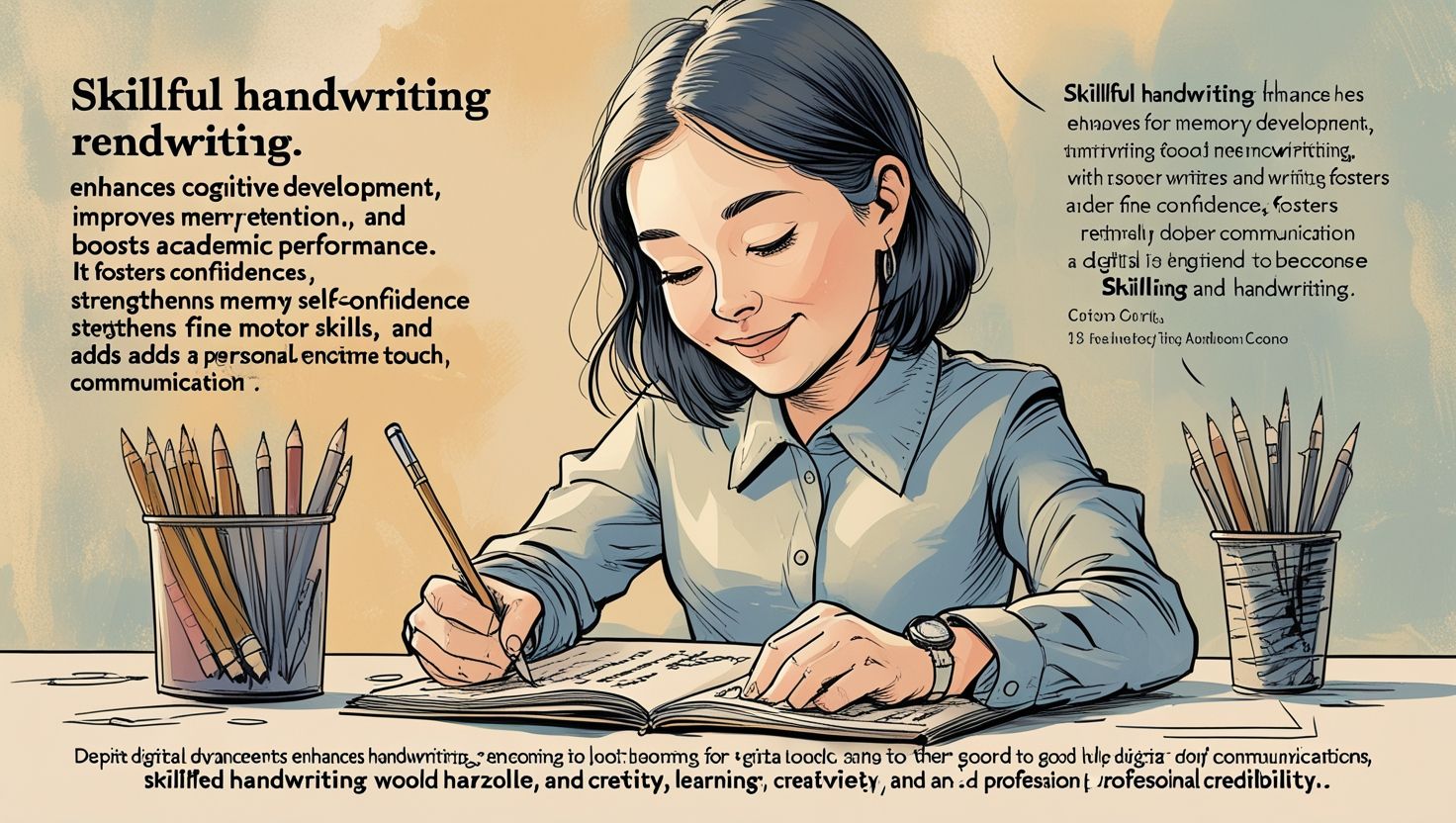Introduction
Skillful Handwriting Importance and Benefits, Handwriting is an essential skill that plays a crucial role in communication, education, and personal development. Despite the digital age’s emphasis on typing and voice recognition, handwriting remains a fundamental skill that fosters cognitive development, enhances memory retention, and improves fine motor skills. Skillful handwriting is not merely about legibility; it also reflects discipline, patience, and personality. This article explores the significance of skillful handwriting, its development, and its long-term benefits.
The Importance of Skillful Handwriting
Handwriting is a critical component of literacy and learning. Several studies suggest that students who write by hand tend to retain information better than those who type. Writing engages multiple areas of the brain, strengthening neural connections and reinforcing learning. Handwriting is also vital in professional and personal settings, as it adds a personal touch to communication, such as handwritten letters, notes, and signatures.
Moreover, neat and skillful handwriting fosters self-confidence. Students who struggle with handwriting often experience frustration and lower self-esteem. Poor handwriting may lead to misinterpretation and negatively impact academic performance. Thus, developing legible and efficient handwriting is essential for effective communication and success in various aspects of life.
Stages of Handwriting Development
Skillful handwriting is acquired through practice and structured learning. The development of handwriting can be categorized into different stages:
- Pre-Writing Stage: In early childhood, children develop pre-writing skills through activities such as drawing, coloring, and scribbling. These activities help build the necessary motor skills for letter formation.
- Letter Formation: As children grow, they learn to form letters systematically. This stage involves practicing uppercase and lowercase letters, focusing on shape, size, and consistency.
- Word and Sentence Construction: Once children master letter formation, they progress to writing words and sentences. Emphasis is placed on spacing, alignment, and punctuation.
- Fluency and Speed: With continued practice, handwriting becomes faster and more natural. Fluency is important for note-taking and written communication in daily life.
- Refinement and Personal Style: Over time, individuals develop their unique handwriting style while maintaining clarity and readability.

Techniques for Improving Handwriting
Improving handwriting requires dedication, practice, and the right techniques. Below are some effective methods for enhancing handwriting skills:
- Proper Posture and Grip: Maintaining an upright posture and holding the pen correctly ensure better control and comfort. A relaxed grip reduces hand strain and enhances writing precision.
- Consistent Practice: Regular practice is key to improving handwriting. Writing daily, tracing letters, and copying texts help in refining letter shapes and improving consistency.
- Use of Lined Paper: Lined paper provides guidance for letter alignment and spacing, ensuring uniformity in writing.
- Slow and Steady Approach: Writing slowly and focusing on each letter’s formation leads to better handwriting. Speed can be improved gradually with practice.
- Strengthening Motor Skills: Engaging in activities that improve fine motor skills, such as finger exercises, drawing, and playing with clay, can enhance handwriting control and dexterity.
- Handwriting Worksheets: Utilizing structured handwriting worksheets helps in practicing letter formations and developing neat handwriting habits.
Benefits of Skillful Handwriting
The advantages of having skillful handwriting extend beyond academic achievement. Some key benefits include:
- Enhanced Cognitive Skills: Writing by hand engages multiple areas of the brain, improving cognitive functions such as memory, comprehension, and critical thinking.
- Better Academic Performance: Students with neat handwriting tend to score better in written exams as their answers are easier to read and evaluate.
- Increased Confidence and Motivation: Good handwriting boosts self-esteem, making students more willing to participate in writing activities.
- Professional Advantages: In professional settings, clear and legible handwriting enhances credibility, whether in filling out forms, signing documents, or taking notes.
- Creative Expression: Handwriting allows individuals to develop a personal writing style, making written communication more expressive and unique.
- Reduced Stress and Anxiety: Writing by hand, especially in activities like journaling, has therapeutic effects that help reduce stress and improve emotional well-being.
The Role of Technology in Handwriting Skills
With the rise of digital tools, many people rely on typing rather than handwriting. While technology provides convenience, handwriting remains relevant. Schools and educators emphasize the importance of maintaining a balance between digital skills and traditional handwriting practices. Digital tablets with styluses are being used to encourage handwriting practice while integrating technology.
Additionally, research suggests that handwriting activates brain regions associated with learning more effectively than typing. Thus, while technology is essential, it should complement rather than replace handwriting skills.
Challenges in Handwriting Development
Despite its importance, many individuals struggle with handwriting due to various reasons:
- Lack of Practice: With increasing reliance on keyboards and screens, handwriting practice has declined, leading to poor handwriting skills.
- Motor Skill Difficulties: Some children and adults face challenges in fine motor coordination, making it difficult to control pen movements.
- Dysgraphia: A neurological disorder that affects writing ability and fine motor skills, making handwriting difficult and often illegible.
- Inconsistent Teaching Methods: Lack of structured handwriting instruction can result in improper letter formation and poor handwriting habits.
- Pressure and Speed Requirements: In academic and professional settings, time constraints may lead to rushed and messy handwriting.
Strategies for Overcoming Handwriting Difficulties
To address handwriting challenges, individuals can adopt the following strategies:
- Personalized Handwriting Exercises: Tailored exercises focusing on individual difficulties can help improve writing skills.
- Assistive Tools: Ergonomic pens, grips, and handwriting aids can provide additional support for those with motor difficulties.
- Handwriting Therapy: Occupational therapy helps individuals with severe handwriting difficulties develop better control and coordination.
- Encouragement and Patience: Positive reinforcement and consistent encouragement motivate learners to improve their handwriting without frustration.
Conclusion
Skillful handwriting remains an essential skill despite technological advancements. It contributes to cognitive development, academic success, and personal expression. By adopting proper techniques and consistent practice, individuals can develop legible, fluent, and aesthetically pleasing handwriting. While digital tools play an important role in modern communication, maintaining proficiency in handwriting ensures a well-rounded approach to literacy and learning. Ultimately, the ability to write skillfully enhances communication, fosters creativity, and leaves a lasting impression in both academic and professional spheres.

7 thoughts on “Skillful Handwriting Importance and Benefits”
Comments are closed.